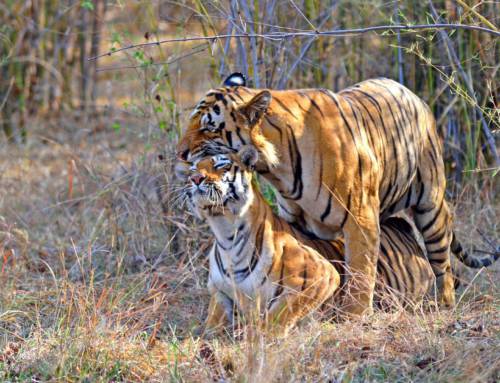Research Article: Hariharan, S., Karanth, K. K., Vasudev, D. (2025). Highs and Lows of Arboreal Life: Space use and Movement Strategies of Lion‐Tailed Macaques (Macaca silenus) in the Western Ghats of India. American Journal of Primatology 87(5) https://doi.org/10.1002/ajp.70042
Blog Author: Sruthi Unnikrishnan
Key Highlights:
- 95% of Asian primates are threatened, mainly due to habitat loss and human disturbance
- The study tracked two monkey groups in the Silent Valley—one deep inside the forest and one near people—to see how they use space.
- The group in the quieter forest showed more ground use and territorial behavior, while the group near humans stuck to mid-canopy levels, showing how they adapt to human presence.
- Both groups slowed down and spent more time in areas with dense canopy and fruiting trees, showing a clear preference for food-rich, connected habitats.
- The study highlights that protecting canopy connectivity and reducing disturbance are key to helping these monkeys survive and stay flexible in changing environments.
Primates are a diverse group comprising more than 500 species and occupying many habitats. However, 68% of primate species and 95% of Asian primates are now facing the threat of extinction, largely due to habitat loss and fragmentation. Many of these species, especially forest specialists like the lion-tailed macaques, are particularly vulnerable to the fragmentation of forests due to road networks, farmlands, and other human activities, as they rely on complex forest ecosystems. Hence, understanding how an individual interacts with its environment with respect to habitat use and other resources is crucial for effective wildlife management and conservation.
At the core of this lies the concept of habitat selection, which is the non-random use of habitat and its components based on their availability. In complex landscapes, this often leads to uneven use of space with some areas becoming high-use “core” areas, whereas others are frequented less. This choice of habitat is shaped by internal factors such as an animal’s body size and reproductive state, as well as external factors like resource distribution, predation, competition, and human disturbance.
An animal’s movement influences access and habitat selection, and therefore, an understanding of its movement patterns becomes essential in informing how an individual perceives and interacts with its environment. The movement of an animal is shaped by a combination of its state, movement capabilities, and the environment. Integrating movement ecology with habitat selection allows for a richer and more nuanced animal-centric understanding of the species’ behaviour.
Human presence and activity can affect the behaviour of an animal even when the said activities are non-lethal, resulting in animals shifting their activity to more nocturnal and avoiding open areas or certain regions. These responses that resemble predator avoidance can impact animal health, fitness, population dynamics, and long-term survival.
The lion-tailed macaque, an endangered and arboreal primate, is endemic to the Western Ghats of India and is highly vulnerable to habitat loss. The current study, led by Sikha Hariharan, strives to understand the spatial ecology of these primates, or in other words, how these primates use habitat space and react to human disturbances. They focused on Silent Valley National Park, comparing two troops, one occupying the core of the park, Sarandhri, which had less human disturbance, and the other occupying the buffer area on the park’s edge, with increased human activity. The study explored how habitat quality and proximity to human activity influence home range size, how they used space both horizontally and vertically, and their movement behaviour. This was done by combining fine-scale movement data with integrated step-selection functions (iSSFs).
The study showed that lion-tailed macaques exhibit substantial behavioural flexibility in their vertical space use, with significant ground use even in the relatively undisturbed forests of Sairandhri. The troops spent over 11% of their time on the ground, a behaviour traditionally associated with degraded habitats. They foraged and accessed water sources on the ground, despite low human disturbance and high canopy connectivity. In contrast, the Keeripara troops showed limited ground use (0.3%) and preferred mid-level canopies, perhaps as a means to avoid predators or humans. The Keeripara troop also had a smaller home range (1.8 km2) compared to the Sairandhri troops, which occupied a larger home range (3.05 km2), likely reflecting restricted habitats and consequent pressures.
The two troops, despite the differences, also showed similarities in their daily movement patterns and a strong dependence on fruiting trees. Interestingly, roads did not significantly affect habitat use in Sairandhri. But the Keeripara macaques preferred areas near roads, possibly using them as travel corridors, although they avoided crossing canopy gaps, as they are risky to cross. These findings suggest that terrestriality in lion-tailed macaques is influenced not only by anthropogenic pressures but also by natural factors like group size, predation risk, and resource distribution, similar to patterns observed in other primates such as orangutans and vervet monkeys.
These behaviors highlight how lion-tailed macaques adapt their movement and space-use strategies in response to local ecological conditions and varying levels of human presence, thereby showing that these macaques make complex, context-dependent choices. Long-term survival of the species requires connected, quality habitats where primates can thrive without constant stress or danger. Fine-scale studies like this help pinpoint which parts of a landscape matter most, and how human presence can shift the balance. Conservation efforts, therefore, must consider these nuanced patterns of space use across different habitats to effectively protect the species.
To access the original article, click here.
Keywords: home range, human disturbance, lion‐tailed macaque, movement‐based habitat selection, protected area, spatial ecology



